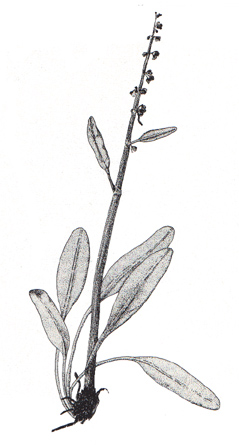
Sourdock
Rumex areticus
(Polygonaceae)

Sourdock
Rumex areticus
(Polygonaceae)
Description:
The members of the genus Rumex, a widespread group
with thirteen species represented in Alaska, are the docks and some of the sorrels.
Rumex arcticus closely resembles the widely known R. crispus, called
curled dock or yellow dock. Rumex arcticus, a perennial about 3 feet
(1 meter) tall, has coarse-ribbed stems growing from a fleshy taproot. Its leaves
are sometimes red-tinged, quite large (especially near the base of the stem),
and long and narrow. A sheath wraps around the stem at the base of each leaf.
The small flowers form panicles or clusters at the end of the stalk. The fruits
are characteristic, three-angled like the flowers, with winglike outgrowths
formed from the three inner sepals.
Distribution:
Rumex crispus, called curled dock due to the wavy
margins of the leaves, is a native of Europe but has naturalized in most parts
of the world, including interior and southcentral Alaska. Rumex arcticus
is common in wet places throughout Alaska, adjacent Canada, and across Siberia.
Constituents:
The tannin from R. hymenosepalus root yields leucodelphinidin
and leucopelargoflidan, which have been employed as cancer chemotherapeutic
drugs. (Lewis)
Medicinal uses:
Known as medicinal since ancient times, the curled dock
or sourdock root has been used as a laxative, astringent, tonic, blood purifier,
and alterative. European herbalists used sorrel or dock as a cooling agent for
fevers, a bitter tonic appetizer, and as a "cordial to the heart."
The Upper Cook Inlet and Nondalton peoples used a tea made from sour-dock root as a medicine for stomach and bladder trouble, for hangover, as a laxative, and, in a very strong decoction, as an emetic.
Roots were cooked, mashed with oil and put on cuts by the people of Mount Saint Elias. (de Laguna) And the identical use of dock is described by Euell Gibbons, whose directions for dock salve follow:
Boil fresh dock root in vinegar just to cover until the root is soft and most of the vinegar has boiled away. Cool until it can be handled, then put the root through a sieve or colander to remove fibers. Combine 1 part dock root to 2 parts petroleum jelly and work in a bit of dry sulfur. This salve has a reputation for curing an itch on man, and mange, saddle sores, and other external conditions on animals.
For relief from pain and itching, a home remedy is to apply the juice of Rumex species growing conveniently close to the stinging nettles (Urtica species) that caused the rash.
Internal use of the root of curled dock (R. crispus) is recommended by Christopher as a blood purifier in cases of poisoning with arsenic or heavy metals. He claims that iron compounds in the root promote excretion by chelation.
Other use:
Rumex hymenosepalus contains as much as 35% tannic
acid. Its root has been used as a commercial tanning agent. (Szczawinski and
Turner)
Warning:
The leaves of dock and sorrel (both Rumex and Oxalis
species) and rhubarb contain soluble oxalates. Oxalic acid is the only organic
acid of plants toxic to animals under natural conditions. (Smith) The soluble
oxalates are sodium and potassium; calcium oxalate is insoluble. A small to
moderate amount of the oxalates is not harmful, and the hazard can be somewhat
mitigated by adding a food rich in calcium to a meal in which oxalate-rich greens
are consumed. Thus the popularity of cream sauce with these greens makes nutritional
sense.
There is also the unlikely hazard of allergic reactions and the chance that long-term consumption of large amounts of the tannin-rich roots might lead to irritation of the bowels or kidneys.
Copyright © 1987 by Eleanor G. Viereck